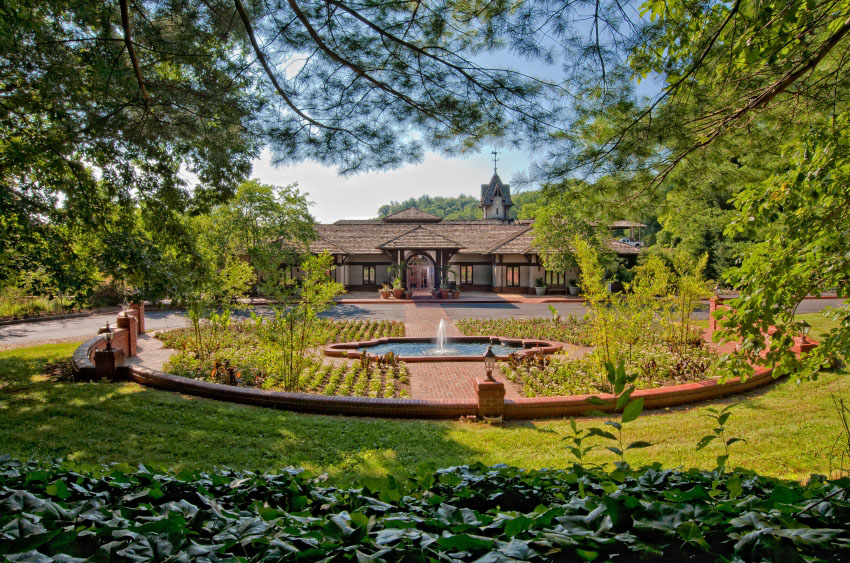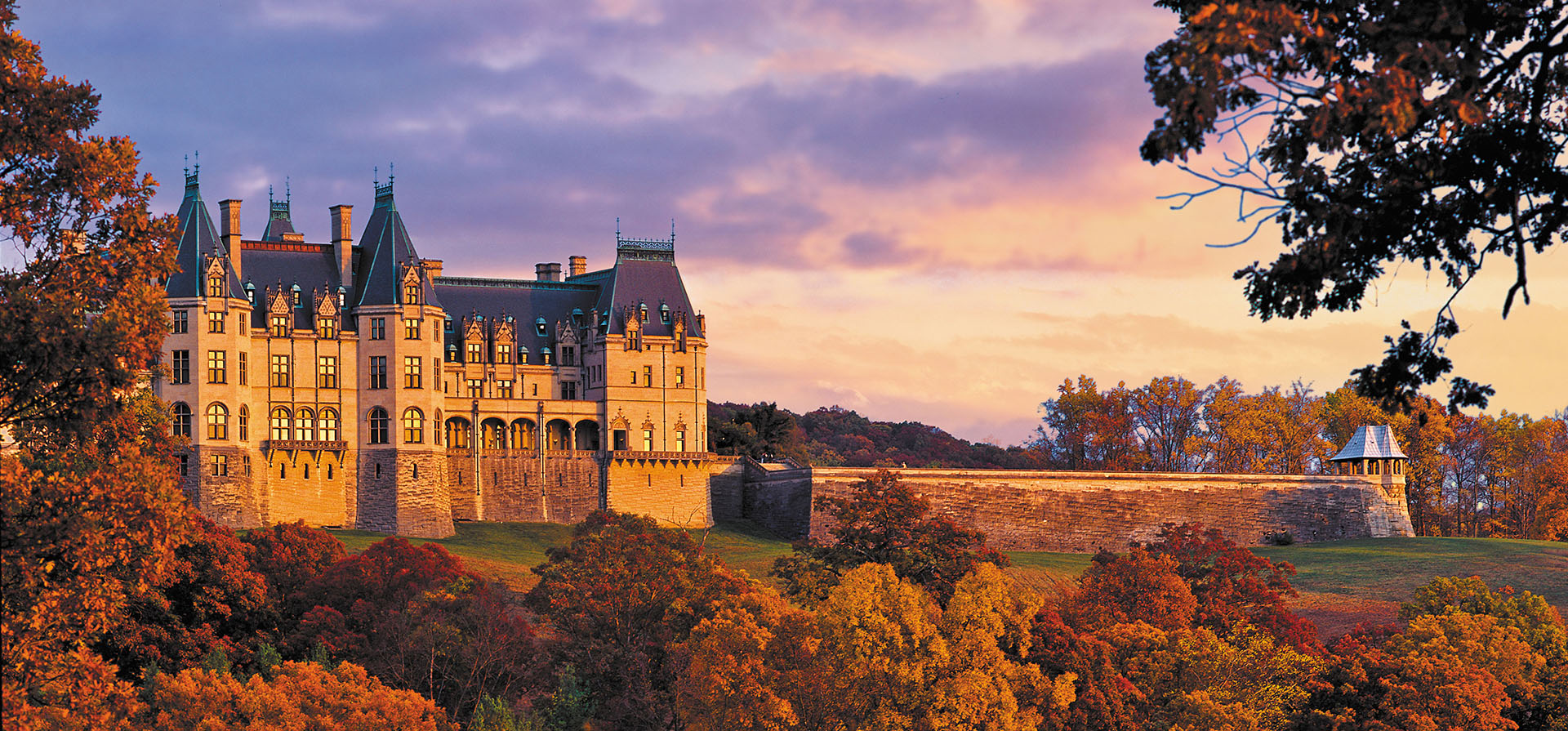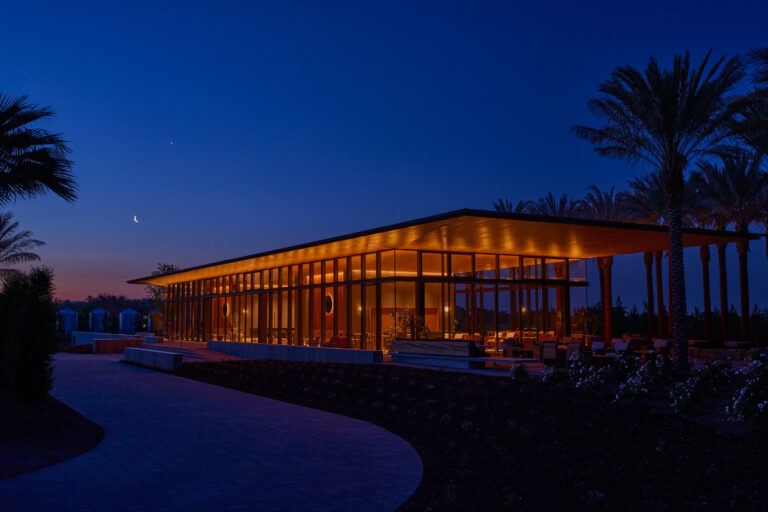
Beaming in the Shadow of the Blue Ridge Mountains, Biltmore Estate is the Jewel in the Vanderbilt Crown
Asheville, North Carolina, has always had its charms, enough to beckon a Vanderbilt. When George Vanderbilt, a dandy of his day with bloodlines to industrialist Cornelius Vanderbilt, discovered the rugged beauty of its rambling outskirts, he purchased 125,000 acres of land and put upon it a grandiose French Renaissance chateau graced with gardens and farmland galore. When the grand dame opened on Christmas Eve of 1895, she revealed herself a marvel—a symbol of terrific ambition, combined talents and exceedingly deep pockets.
The 250-room manse, which its owner dubbed his “little cabin in the woods,” is a reflection of Vanderbilt bravura—the largest private home in America designed by architect Richard Morris Hunt, with grounds by noted landscape architect Frederick Law Olmsted of Central Park fame. When finished, Biltmore House, with its bachelor’s wing befitting the needs of a proper hunting party, was where George Vanderbilt assumed the role of courtly country gentleman.

As a theater for Vanderbilt and his guests to flit about in all their Gilded Age glory, Biltmore House parades a full array of finery fit for a tycoon, from the glass-roofed Winter Garden to the gleaming oak Billiard Room. As a kind of castle in miniature, the house’s statuesque Banquet Hall soars with a seven-story ceiling that surveys a vast table and Flemish tapestries. The Music Room sings with true rarities; porcelain figurines and candlesticks made for Austrian Habsburg empresses. The elongated Tapestry Gallery displays a priceless portrait by John Singer Sargent, and the library introduces George Vanderbilt as a bibliophile fixed on Dickens. Here, along with nearly half of the master’s mammoth book collection is a fresco of The Chariot of Aurora, by Italian artist Giovanni Pellegrini, originally painted for the Pisani Palace in Venice.
While sumptuous suites and living spaces for the Vanderbilt family and guests swallow the second and third floors, respectively, the basement level is an homage to progress, with all that money could buy, including a colossal 70,000-gallon heated indoor pool with underwater lighting, a gymnasium with early forerunners to massage showers, and a bowling alley. Also lurking on this level is the artery of house operations—the servants’ domain. Technologically advanced for its era, this Downton Abbey double boasts a warren of spartan yet surprisingly cozy servant quarters that mark a step up in what was typical for those in service at the time. Several kitchens, a pantry with manual and electric dumbwaiters, and an expansive laundry room with an adjacent drying room are also here. The dining area is robustly dimensioned, and the service entrance recalls provisions of epic proportions, from steamer trunks to 30-dozen eggs a week.

But it’s the gardens that give Biltmore House her famed flourish. Along with a snarl of outstretched trees buttressing bold blooms are age-old roots festooning columns and spidering up walls. Saunter these glorious, well-cultivated grounds and beauty nesting in rich, well-tended earth abounds. The contrast between this lush setting and the imposing stone of Biltmore House makes the scene truly something to behold, particularly each spring, when more than two miles of pathways avail verdant forests, serene meadows and separate gardens dedicated to roses, shrubs, azaleas and more. As the showpiece, the conservatory cultivates exotic ferns, palms and orchids beneath its arresting glass roof.
Remarkably, given its magnitude, Biltmore House remained without a mistress until 1898, when George Vanderbilt married socialite Edith Stuyvesant Dresser. Admired for her countenance and cultivated ways, it was Edith who agreed to have the house safeguard a number of artistic riches from the National Gallery of Art at the behest of its director David Finley during World War II. (A former guest of Biltmore, Mr. Finley, fearing reports of German submarine activity along the Atlantic Coast, had been impressed with the home’s fireproof features.) But it was Edith and George’s only child, Cornelia, who played perhaps the most significant role in the future of Biltmore House, spearheading its public opening in 1930, en route to earning National Historic Landmark recognition in 1963.
Today, Biltmore House retains her title as a true American treasure.

Spring Flings
Biltmore Blooms
Spring arrives with immense floral displays, featuring nearly 100,000 tulips, celebrating the legacy of the estate’s master horticultural planner Frederick Law Olmsted. Biltmore restaurants will feature special menu items, with the Winery offering wine seminars. March 19-May 26
Flowers to Wear: A Boutonniere & Corsage Bar
The Inn invites guests to watch or participate as a resident Biltmore floral design expert teaches a how-to in creating wearable flower creations. March 26, May 7, June 18
Easter Egg Hunt
The Easter Rabbit makes his annual appearance on Biltmore’s Front Lawn on Easter Sunday. Grand Easter Egg Hunts at 11 a.m., 1 and 3 p.m. Children ages 2 to 9 attend the hunt for free when accompanied by an estate pass holder or a ticketed adult. March 27
Grape Stomp in Antler Hill Village
Adults and kids alike are invited to take part in this ancient maceration practice, long an important part of winemaking. A grape stomp souvenir commemorating the experience will be provided. Complimentary, no reservation required. Weekends May 14–Sept. 25
Biltmore Estate
One Lodge Street, Asheville, North Carolina
800.411.3812 | Biltmore.com
Photos Courtesy of the Biltmore Company




